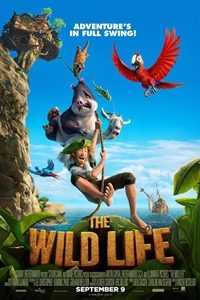 This Crusoe story, ‘The Wild Life’, is visually pleasant but feels lost
This Crusoe story, ‘The Wild Life’, is visually pleasant but feels lost
Directed by: Vincent Kesteloot and Ben Stassen
“The Wild Life” – “Dogs and other animals – goats, donkeys, cows, a grumpy rooster – continue to change my writing life.” - author Jon Katz
In the “The Wild Life”, directors Vincent Kesteloot and Ben Stassen create an animated version of the novel, “Robinson Crusoe”, and their vision includes animals – a whole lot of animals - who help and hinder our hero’s time on a deserted island.
As the movie opens, a pirate ship with perceived jagged teeth in its bow moves through the water, and the ruffians onboard discover Crusoe’s (Matthias Schweighofer) shipwrecked boat. The pirates rescue him and his trusted parrot, Tuesday, and Crusoe recants his story to Long John Silver and the others, as the film moves into an extended flashback.
He explains how he found himself trapped below deck on a large sailing ship, when it began to fall apart. Crusoe’s shipmates rowed off to safety, while he crashed with his loyal dog, Aynsley, and two horribly caustic cats, Mal and May.
The film clearly defines these two cats as the main antagonists, and they were not particularly thrilled with Crusoe before the crash, because he stopped them from stealing a chicken, or as Mal and May called it, trying to have lunch.
There are no free lunches for Crusoe, as he struggles to define his new space on the island, and seven native animals – who resemble various Disney-like creations - could be friends or foes. The natives - including a parrot (Tuesday), a bluebird, a chameleon, a porcupine, a goat, and two other animals (who I could not recognize) - have never seen a human being before and approach him with some curiosity and much caution.
Now, I had much curiosity and determination to discover the names of these new characters, but after 30 minutes, I mostly gave up. There are literally too many animals to keep track of and catalog, and all of their personalities seem to blend together except for Tuesday and an elderly goat with sight problems named Scrubby. I had to play catch up with the other five.
In “The Lion King” (1994), Simba becomes lost in the jungle, but the movie introduces us to Timon and Pumbaa, and they sing “Hakuna Matata”. Their verbal preamble followed by their (now) famous song help establish these characters and define their personalities. The two become allies with Simba, and we the audience easily identify them.
“In the Wild Life”, Kesteloot and Stassen introduce all seven at once, but without a distinctly signature quip, moment or song, the individual characters do not particularly stand out, and as previously mentioned, I was playing catch up.
Eventually, this collection of island creatures become friendly with Crusoe, and since none of them studied to be engineers, they create a series of Rube Goldberg contraptions to gather water and other comforts. Life appears grand, except those mangy cats multiplied like rabbits and try to crash their party (i.e.: cause havoc and attempt to eat most of them).
Watching all of these events, I developed some incarnation of island fever, as the film’s runtime seemed like over two hours, but miraculously, it ended abruptly after just 90 minutes. Although the native animals overcame their fear of an unknown human, and Crusoe overcame his initial inability to adapt to life on the isle, the overall narrative felt like a collection of nonevents.
Now, some of the chase scenes between the army of felines and our new friends are creative, and one extended waterslide sequence is particularly fun. The picture also carries a lot of colorful beauty, and the tropical environment brings visual pleasantries to the screen.
Regrettably, without much of a story or establishment of characters who we emotionally connect with, the visuals alone are not enough. Oddly, during the film’s epilogue, it showcased – in still photos - two desirable outcomes for both Crusoe and Tuesday. In other words, after the movie ended, it – only then – presented new elements to its thin and circular script.
Oh well. Hakuna matata. (1.5/4 stars)
Jeff – a member of the Phoenix Critics Circle – has penned film reviews since 2008 and graduated from ASU’s Walter Cronkite School of Journalism. Follow Jeff and the Phoenix Film Festival on Twitter @MitchFilmCritic and @PhoenixFilmFest, respectively.









